Translate this page into:
Pressure-induced facial follicular papules: 15 cases of an under-recognised dermatosis
Corresponding author: Prof. M. Ramam, Department of Dermatology and Venereology, All India Institute of Medical Sciences, New Delhi, India. mramam@hotmail.com
-
Received: ,
Accepted: ,
How to cite this article: Dev T, Balaji G, Mehta N, Ramam M. Pressure-induced facial follicular papules: 15 cases of an under-recognised dermatosis. Indian J Dermatol Venereol Leprol 2022;88:419-22.
Sir,
Repetitive prolonged pressure and friction results in cutaneous changes such as knuckle pads from boxing and prayer sign on the forehead. Relieving pressure/friction is an important element of treatment. The association with pressure appears under-recognised in a follicular facial eruption leading to inadequate management. We describe 15 patients with this distinctive eruption that, once identified, can be easily treated by a simple change in posture.
We evaluated ten men and five women, aged 10–59 years who presented to the department of dermatology at the All India Institute of Medical Sciences, New Delhi, with asymptomatic, hyperpigmented papules on the face that appeared insidiously over a period of two months to 20 years.
There were tiny, closely aggregated keratotic papules on a background of ill-defined dark brown pigmentation [Figure 1]. In three patients, there were a few slightly larger, yellowish-white to dark brown comedones. Papules were noted on the cheek in eight (53.3%) patients, chin in four (26.6%), left mandibular jawline in two (13.2%) and both the jawline and neck in one (6.6%). The eruption was bilateral in two and unilateral in nine patients with the left side affected in eight and the right in one; it was located centrally on the chin in the remaining four patients [Table 1]. All patients were right handed.

- Demonstrating the resting position of face against palm (Case 6)
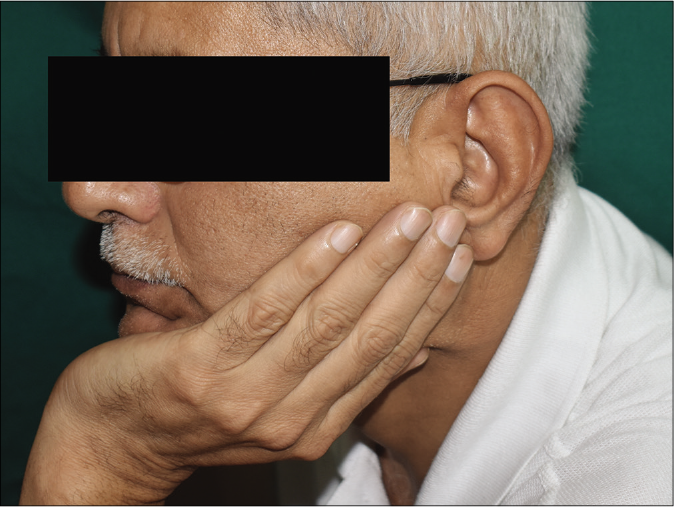
- Demonstrating the resting position of face against palm (Case 8)
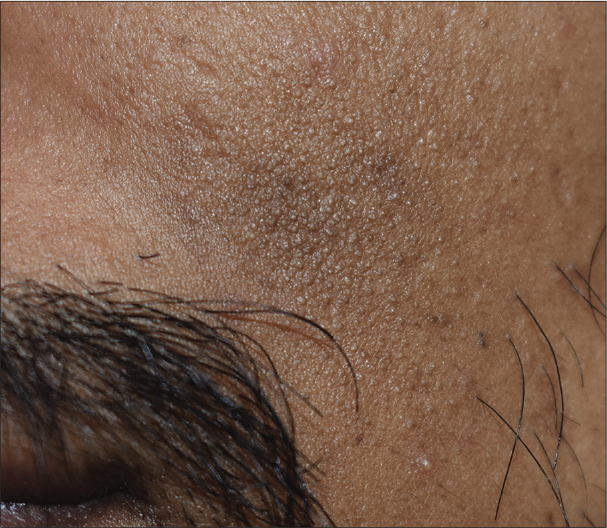
- Follicular papules and pigmentation at the corresponding site (Case 6)
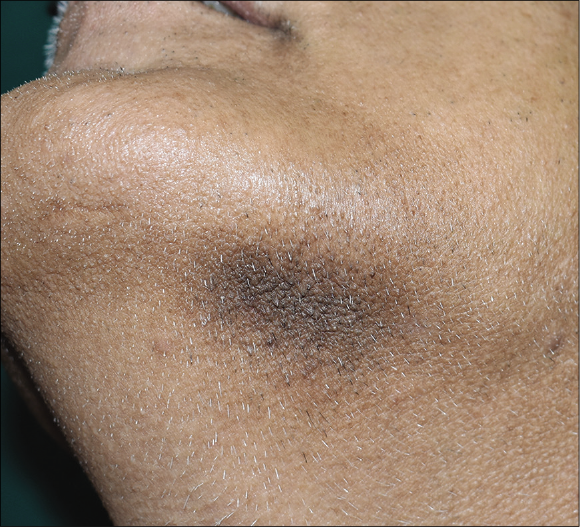
- Follicular papules, pigmentation and slight thickening of skin at the corresponding site (Case 8)
| Age (year) | Gender | Site involved | Duration | Occupation | Activity associated with prolonged pressure | History of atopy | Duration of treatment | Improvement (%) | Duration of follow-up |
|---|---|---|---|---|---|---|---|---|---|
| 17 | F | Chin | One year | Student | Studying | Yes | NA | NA | Baseline |
| 18 | M | Left cheek | Six years | Student | Studying, watching television | No | Six months | Nearly complete | Six months |
| 19 | F | Chin | Five years | Student | Studying, general posture while conversing | Yes | Six months | Complete | Six months |
| 21 | F | Chin | Four months | Student | Listening to lectures | No | NA | NA | Baseline |
| 27 | F | Left mandibular area | Two years | Student | Studying, watching television | Yes | Six months | Nearly complete | Six months |
| 29 | M | Left cheek | Two years | Student | Studying, watching television | No | Three months | Marked | Three months |
| 30 | M | Left cheek | Six years | Student | Studying, reading, watching television | No | One month | Slight | One month |
| 59 | M | Left mandibular area | 20 years | Professor | Studying, reading | No | Two weeks | Marked | Six months |
| 12 | F | Left mandibular area, left side of neck | Two months | Student | Studying, watching television | Yes | One month | Marked | One month |
| 21 | M | Left cheek | Two years | Medical student | Studying | Yes | NA | Marked | One month |
| 22 | M | Left cheek | One year | Student | Studying | NA | One month | Marked | One month |
| 22 | M | Cheeks, more on left | Ten years | Student | Studying, watching television | Yes | One month | Marked | One month |
| 10 | M | Chin | One year | Student | None reported | No | One month | Marked | One month |
| 27 | M | Cheeks, more on right | Three years | Student | Studying | Yes | NA | NA | Baseline |
| 17 | M | Right cheek | One year | Student | None reported | No | NA | NA | Baseline |
Seven (46.6%) patients had a history of atopy; there were no other cutaneous or systemic illnesses. Thirteen (86.7%) patients were in the habit of resting their face on their hand for long periods while studying or watching television. In all these patients, the papules corresponded exactly to the area of the face that rested on the palm.
Dermoscopy was done in four patients, out of which two revealed coiled hair shafts in the affected area. There were no follicular plugs. Two patients consented for skin biopsy. The histopathological findings included focally compact hyperkeratosis, papillomatosis and mild acanthosis with one biopsy showing a keratotic follicular plug [Figure 2].
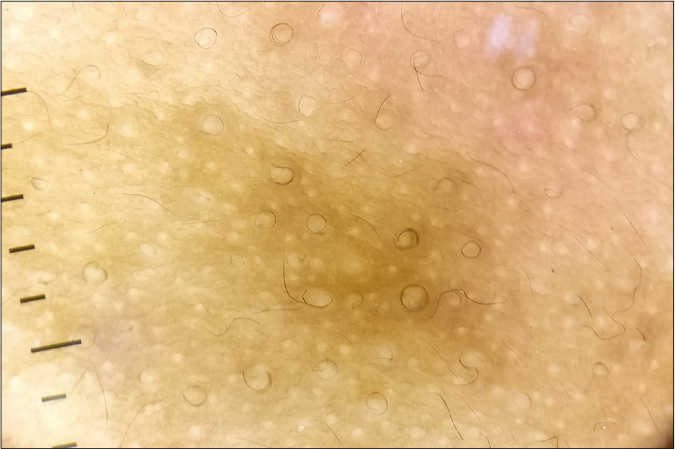
- Case 9: Polarized dermoscopy(×10) showing ill-defined area of yellowish to dark brown discolouration in the centre surrounded by a zone of light brown pigmentation and mild erythema and multiple coiled hair shafts in the affected area
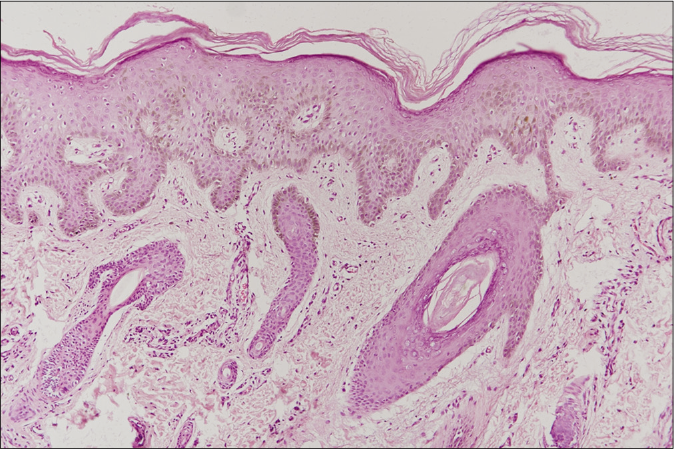
- Biopsy from a keratotic papule showing focally compact hyperkeratosis, papillomatosis, mild acanthosis and follicular plugging (haematoxylin and eosin, ×100)
All patients were advised to stop resting their face on their hand and prescribed topical tretinoin 0.05% for application at night. There was near complete resolution in patients who were compliant with instructions [Figure 3 and Table 1].
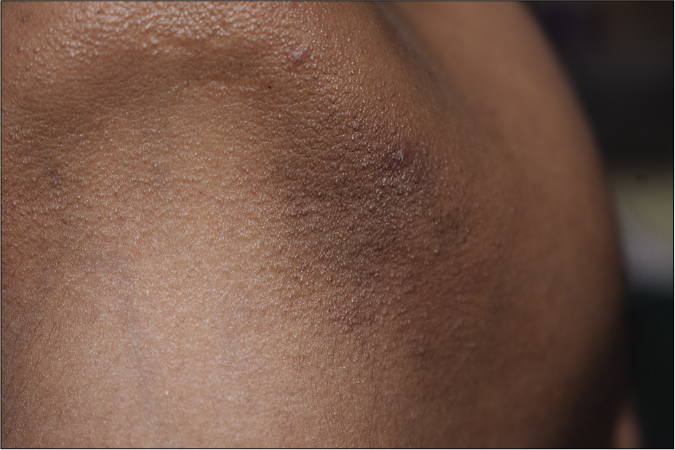
- Multiple tiny, closely aggregated follicular papules involving the left jawline, at the baseline
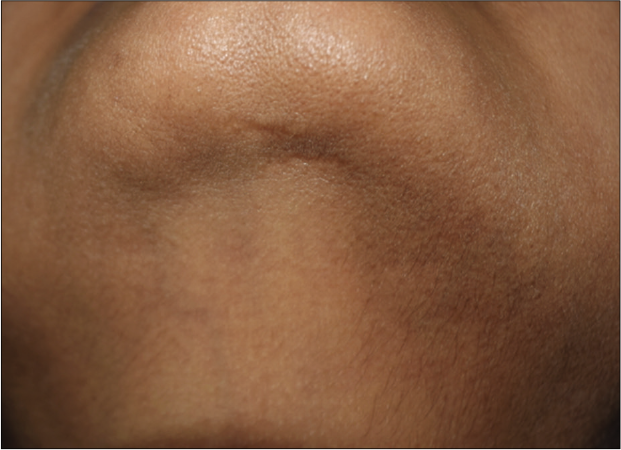
- Marked improvement after 6 months of application of tretinoin (0.05%) cream and avoidance of friction (Case 5)
The development of grouped follicular papules exclusively on portions of the face rested on the palm for several hours a day with resolution when posture was changed provides strong evidence for prolonged pressure as the cause of this eruption. Patients rested their face on the hand in slightly different ways and this resulted in papules at different places but the distribution always corresponded to the site of contact with the palm. These papules lacked erythema and were monomorphic, unlike acne where pustules, comedones and/or inflammatory papules can be seen. In the initial few cases, the differentials of keratosis pilaris, lichen spinulosus and trichostasis spinulosa were considered.
Padilha-Goncalves described traumatic anserine folliculosis, a similar eruption in 11 patients who had a history of prolonged friction on the chin, jawline and neck. Patients were aged four–21 years and the author suggested that the delicate skin of adolescents was predisposed to the effects of chronic friction,1 though we saw the eruption in older people, too. The condition is probably not uncommon as we saw 15 patients over a period of nine months in our department.1-11
Interestingly, patients readily accepted the explanation of pressure/friction when it was pointed out to them but they were not themselves aware of the causal relation. Removal of pressure, along with a topical retinoid or keratolytic agent, led to gradual resolution over several weeks.
Acknowledgement
None.
Declaration of patient consent
The authors certify that they have obtained all appropriate patient consent.
Financial support and sponsorship
Nil.
Conflicts of interest
There are no conflicts of interest.
References
- Keratotic Papular Lesions on the Chin in Young Females. Berlin: Abstracts of the Joint Meeting of the 10th European Annual Meeting of the Society for Cutaneous Ultrastructure Research and the 4th International Dermatopathological Colloquium of the International Society of Dermatopathology 1983. p. :39-40.
- [Google Scholar]
- Familial keratotic papular lesions on the chin. Int J Dermatol. 1985;24:320-1.
- [CrossRef] [PubMed] [Google Scholar]
- Follicular keratosis of the chin treated with 1.24r-dihydroxyvitamin d3 ointment. Pediatr Dermatol. 2007;24:412-14.
- [CrossRef] [PubMed] [Google Scholar]
- Traumatic anserine folliculosis. Indian Dermatol Online J. 2017;8:59-61.
- [CrossRef] [PubMed] [Google Scholar]
- Clinicoepidemiological profile of patients with traumatic anserine folliculosis: A retrospective study from a tertiary care centre in North India. Indian J Paediatr Dermatol. 2020;21:270-4.
- [CrossRef] [Google Scholar]





